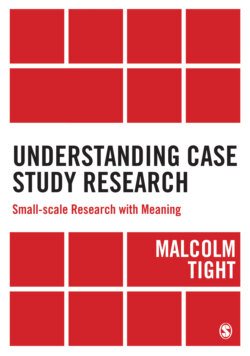Читать книгу Understanding Case Study Research - Malcolm Tight - Страница 22
На сайте Литреса книга снята с продажи.
Case Study as a Research Design
ОглавлениеWhere does case study sit in comparison with other research designs? We have already seen (in Box 3.1) that research designs, and the place of case study within them, have been variously categorised by different authors. There is, then, no single, definitive and widely accepted classification of research designs.
We will examine in more detail, however, one of the classifications already mentioned, that proposed by Bryman (2004). Bryman’s classification has, to my mind, the considerable advantages of being both straightforward and neatly structured. He begins by explaining what he means by research design:
A research design provides a framework for the collection and analysis of data. A choice of research design reflects decisions about the priority being given to a range of dimensions of the research process. These include the importance attached to: expressing causal connections between variables; generalizing to larger groups… understanding behavior… in its specific social context; having a temporal appreciation of social phenomena. (p. 27, emphasis in original)
Five research designs are then identified: experimental (the manipulation of one variable to measure its impact on another), cross-sectional (‘the collection of data on more than one case and at a single point in time’ [p. 41, emphasis in original]), longitudinal (the repeated collection of data on at least two different occasions), case study (which Bryman defines simply as ‘the detailed and intensive analysis of a single case’ [p. 48]) and comparative (‘the study using more or less identical methods of two contrasting cases’ [p. 53]).
In Bryman’s terms, then, case study as a research design is less concerned with establishing causal connections, generalisation or temporal connections; it focuses instead on ‘understanding behavior in its specific social context’. Or, to put it the other way around, if you are engaging in a research project with the intention of understanding some aspect of behaviour in its social setting, case study is an obvious and appropriate research design to employ.
Interestingly, case study would also be a possible approach (note that I am now using the term ‘approach’ rather than ‘design’ to indicate that an alternative overall design to case study is being employed) for at least three of the other four research designs suggested by Bryman. Indeed, this is clearly suggested by his use of the word ‘case’ in the sense of ‘item’ or ‘individual’ in the quotations given. Thus, a comparative design could proceed using a multiple case study approach, as might a cross-sectional design (though here a survey is probably a more obvious approach). A longitudinal design might involve returning to the same case study (or case studies) on a number of occasions.
The only one of Bryman’s five designs where case study does not suggest itself as an approach is the experimental design, though even here the manipulation of the variable(s) involved could take place within cases (see the discussion of experiment as a research design that can be combined with case study in Chapter 6). What this discussion illustrates, of course, is the care needed in talking about, and distinguishing between, case study and cases. As was noted in Chapter 2, all research involves the study of cases in some form; case study is a research design which focuses on the detailed study of a particular case or cases.
